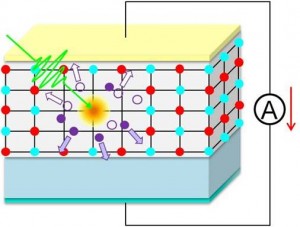New concept correlated electron solar cell demonstrated Competing electronic phases at interface enable higher efficiency solar cells

When a light is illuminated on a charge-ordered insulating state typically observed in transition-metal oxides, it is known that the collective activation of localized charges occurs leading to phase transition from an insulating into a metallic state. During this photoinduced phase transition, multiple charge carriers are generated from one photon. Once this multiple carrier generation is applied to a solar cell, great improvement in photo-electron energy transfer can be expected. This “correlated electron solar cell” has been attracting attention as a potential next-generation solar cell.

© 2014 Masao Nakamura.
Schematic of a phase transition from an insulating to metallic state observed when shining a light on a charge-ordered insulator as localized charge carriers become mobile simultaneously. During this phase transition, multiple charge carriers are generated from one photon, which is called multiple carrier generation. In order to utilize this phenomenon in a photovoltaic device, it is necessary to invoke the photoinduced phase transition at the interface of a heterojunction as shown in the figure.
The research group of Professor Masashi Kawasaki at the Graduate School of Engineering has investigated the photovoltaic properties under magnetic fields of heterojunctions consisting of a semiconductor and perovskite-type manganites, which are a well-known system showing photoinduced phase transition. The researchers found that the photo-electron conversion efficiency is greatly enhanced by applying magnetic fields when the manganite has an appropriate lattice distortion and chemical composition. This result indicates that a phase competing state is induced at the interface of this junction. In addition, such a junction showing a clear a magneto-photovoltaic effect had a larger short-circuit current compared to other junctions with small magneto-photovoltaic effect. A possible scenario for this photocurrent enhancement is that local photoinduced phase transitions occur near the interface accompanied by multiple carrier generation. This important result are is a significant step towards the development of a correlated electron solar cell.
Paper
Z. G. Sheng, M. Nakamura, W. Koshibae, T. Makino, Y. Tokura, and M. Kawasaki,
“Magneto-tunable photocurrent in manganite based heterojunctions”,
Nature Communications Online Edition: 2014/8/1 (Japan time), doi: 10.1038/ncomms5584.
Article link (Publication, UTokyo Repository)
Links
Graduate School of Engineering
Department of Applied Physics, Graduate School of Engineering
Quantum-Phase Electronics Center (QPEC), Graduate School of Engineering






